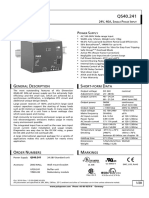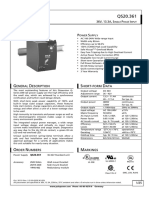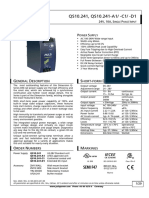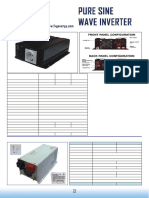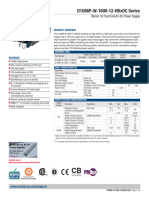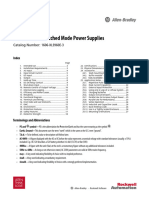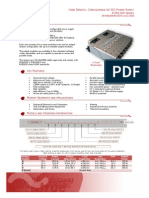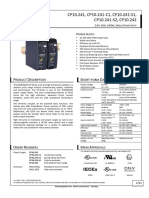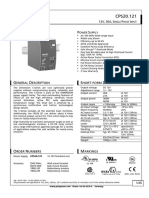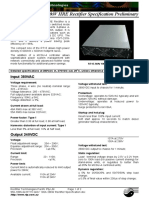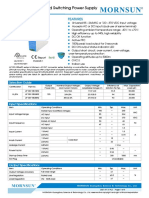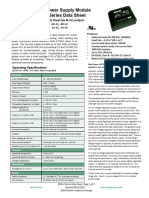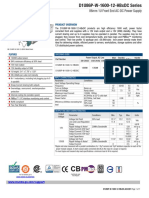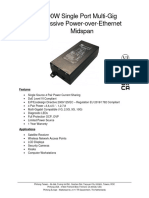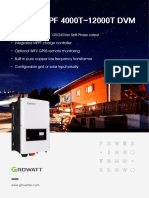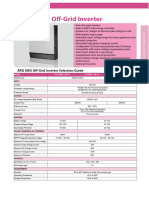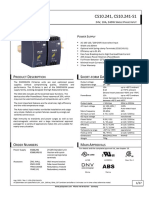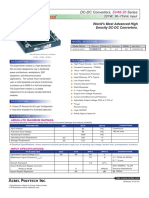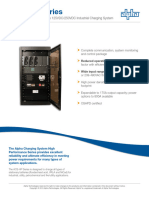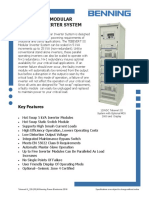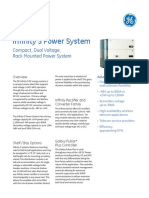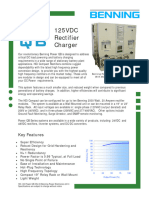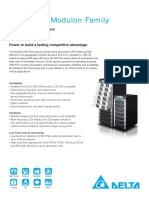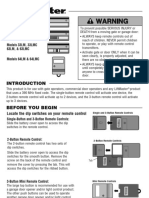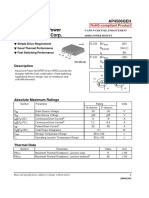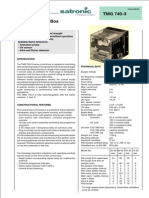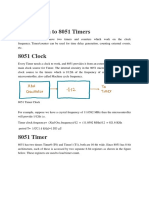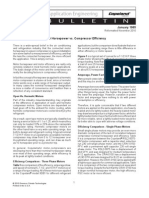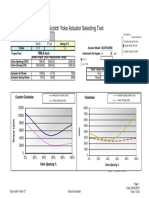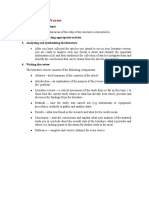Qs40e484 2
Qs40e484 2
Uploaded by
Mostafa SalahCopyright:
Available Formats
Qs40e484 2
Qs40e484 2
Uploaded by
Mostafa SalahOriginal Title
Copyright
Available Formats
Share this document
Did you find this document useful?
Is this content inappropriate?
Copyright:
Available Formats
Qs40e484 2
Qs40e484 2
Uploaded by
Mostafa SalahCopyright:
Available Formats
QS40.
484
Q-Series 48V, 20A, SINGLE PHASE INPUT
POWER SUPPLY
▪ AC 200-240V Input
▪ Width only 125mm, Weight only 1.8kg
▪ 95.0% Full Load and Excellent Partial Load Efficiencies
▪ 50% BonusPower, 1440W for up to 4s
▪ 55A High Peak Current for 25ms for Easy Fuse Tripping
▪ Safe HiccupPLUS Overload Mode
▪ Active PFC (Power Factor Correction)
▪ Negligible Low Input Inrush Current Surge
▪ Full Power Between -25°C and +60°C
▪ Current Sharing Feature for Parallel Use
▪ Internal Data Logging for Troubleshooting Included.
▪ DC-OK Relay Contact
▪ Shut-down Input
▪ 3 Year Warranty
PRODUCT DESCRIPTION SHORT-FORM DATA
The most outstanding features of the DIMENSION Q- Series DIN Output voltage DC 48V nominal
rail power supplies are the extremely high efficiencies and the Adjustment range 48 - 54Vdc
small sizes, which are achieved by a synchronous rectification
Output current 20 – 17.8A continuous
and other technological designs.
30 – 26.7A short term (4s)
The QS40.484 is a device for 200-240V mains voltages. Large Output power 960W continuous
power reserves of 150% support the starting of heavy loads such
1440W short term (4s)
as DC-motors or capacitive loads. In many cases this allows the
Output ripple < 150mVpp 20Hz to 20MHz
use of a unit from a lower wattage class which saves space and
money. Input voltage AC 200-240V -15%/+10%
Mains frequency 50-60Hz ±6%
High immunity to transients and power surges as well as low
AC Input current 4.6A at 230Vac
electromagnetic emission makes usage in nearly every
environment possible. Power factor 0.96 at 230Vac
AC Inrush current 14A peak at 230Vac
The integrated output power manager and input fuses as well as
the near zero input inrush current make installation and usage Efficiency 95.0% at 230Vac
simple. Diagnostics are easy due to the DC-OK relay, a green DC- Losses 50.5W at 230Vac
OK LED and the red overload LED. Temperature range -25°C to +70°C operational
A large international approval package for a variety of Derating 24W/°C +60 to +70°C
applications makes this unit suitable for nearly every Hold-up time 30ms at 230Vac
application. Dimensions 125x124x127mm WxHxD
Weight 1800g
ORDER NUMBERS MAIN APPROVALS
For details and the complete approval list, see chapter 22.
Power Supply QS40.484 48-54V Standard unit
Accessory ZM2.WALL Wall mount bracket
UF20.481 Buffer unit
YR40.482 Redundancy module UL508 UL 60950-1 Marine
Marine
Jul. 2023 / Rev. 3.4 DS-QS40.484-EN
All parameters are specified at 48V, 20A, 230Vac, 25°C ambient and after a 5 minutes run-in time unless otherwise noted. 1/30
www.pulspower.com Phone +49 89 9278 0 Germany
QS40.484
Q-Series 48V, 20A, SINGLE PHASE INPUT
INDEX
Page Page
1. Intended Use............................................................. 3 23. Regulatory Product Compliance............................... 20
2. Installation Instructions ............................................. 3 24. Physical Dimensions and Weight.............................. 21
3. AC-Input.................................................................... 4 25. Accessories ............................................................. 22
4. Input Inrush Current .................................................. 5 25.1. ZM2.WALL - Wall mounting bracket ............... 22
5. DC-Input ................................................................... 5 25.2. UF20.481 - Buffer module .............................. 22
6. Output ...................................................................... 6 25.3. YR40.482 - Redundancy Module ..................... 23
7. Hold-up Time ............................................................ 8 26. Application Notes.................................................... 24
8. DC-OK Relay Contact ................................................. 9 26.1. Repetitive Pulse Loading ................................ 24
9. Shut-down Input ....................................................... 9 26.2. Peak Current Capability.................................. 25
10. Remote Control of Output Voltage........................... 10 26.3. External Input Protection ............................... 25
11. Internal Data Logging............................................... 10 26.4. Charging of Batteries ..................................... 26
12. Efficiency and Power Losses..................................... 11 26.5. Output Circuit Breakers.................................. 26
13. Lifetime Expectancy and MTBF ................................ 12 26.6. Parallel Use to Increase Output Power ........... 27
14. Functional Diagram ................................................. 12 26.7. Parallel Use for Redundancy........................... 27
15. Terminals and Wiring............................................... 13 26.8. Series Operation ............................................ 28
16. Front Side and User Elements .................................. 14 26.9. Inductive and Capacitive Loads....................... 28
17. EMC ........................................................................ 15 26.10. Back-feeding Loads ........................................ 28
18. Environment ........................................................... 16 26.11. Operation on Two Phases .............................. 29
19. Protection Features ................................................. 17 26.12. Use in a Tightly Sealed Enclosure.................... 29
20. Safety Features ....................................................... 17 26.13. Mounting Orientations................................... 30
21. Dielectric Strength ................................................... 18
22. Approved, Fulfilled or Tested Standards ................... 19
The information presented in this document is believed to be accurate and reliable and may change without notice.
No part of this document may be reproduced or utilized in any form without permission in writing from the publisher.
TERMINOLOGY AND ABREVIATIONS
PE and symbol PE is the abbreviation for Protective Earth and has the same meaning as the symbol .
Earth, Ground This document uses the term “earth” which is the same as the U.S. term “ground”.
t.b.d. To be defined, value or description will follow later.
AC 230V A figure displayed with the AC or DC before the value represents a nominal voltage with standard tolerances
(usually ±15%) included.
E.g.: DC 12V describes a 12V battery disregarding whether it is full (13.7V) or flat (10V)
230Vac A figure with the unit (Vac) at the end is a momentary figure without any additional tolerances included.
50Hz vs. 60Hz As long as not otherwise stated, AC 230V parameters are valid at 50Hz mains frequency.
may A key word indicating, flexibility of choice with no implied preference.
shall A key word indicating a mandatory requirement.
should A key word indicating flexibility of choice with a strongly preferred implementation.
Jul. 2023 / Rev. 3.4 DS-QS40.484-EN
All parameters are specified at 48V, 20A, 230Vac, 25°C ambient and after a 5 minutes run-in time unless otherwise noted. 2/30
www.pulspower.com Phone +49 89 9278 0 Germany
QS40.484
Q-Series 48V, 20A, SINGLE PHASE INPUT
1. INTENDED USE
This device is designed for installation in an enclosure and is intended for commercial use, such as in industrial control, process control,
monitoring and measurement equipment or the like.
Do not use this device in equipment, where malfunctioning may cause severe personal injury or threaten human life without additional
appropriate safety devices, that are suited for the end application.
If this device is used in a manner outside of its specification, the protection provided by the device may be impaired.
2. INSTALLATION INSTRUCTIONS
WARNING Risk of electrical shock, fire, personal injury or death.
- Turn power off before working on the device and protect against inadvertent re-powering.
- Do not open, modify or repair the device.
- Use caution to prevent any foreign objects from entering into the housing.
- Do not use in wet locations or in areas where moisture or condensation can be expected.
- Do not touch during power-on, and immediately after power-off. Hot surface may cause burns.
Obey the following installation instructions:
This device may only be installed and put into operation by qualified personnel.
This device does not contain serviceable parts. The tripping of an internal fuse is caused by an internal defect.
If damage or malfunction should occur during installation or operation, immediately turn power off and send unit to the factory for
inspection.
Install device in an enclosure providing protection against electrical, mechanical and fire hazards.
Install the device onto a DIN rail according to EN 60715 with the input terminals on the bottom of the device. Other mounting
orientations require a reduction in output current.
Make sure that the wiring is correct by following all local and national codes. Use appropriate copper cables that are designed for a
minimum operating temperature of 60°C for ambient temperatures up to +45°C, 75°C for ambient temperatures up to +60°C and 90°C
for ambient temperatures up to +70°C.
Ensure that all strands of a stranded wire enter the terminal connection. Unused screw terminals should be securely tightened. Use
ferrules for wires on the input terminals.
The device is designed for pollution degree 2 areas in controlled environments. No condensation or frost is allowed.
The enclosure of the device provides a degree of protection of IP20. The enclosure does not provide protection against spilled liquids.
The device is designed for overvoltage category II zones.
The device is designed as “Class of Protection I” equipment according to IEC 61140. Do not use without a proper PE (Protective Earth)
connection.
The device is suitable to be supplied from TN, TT or IT mains networks. The continuous voltage between the input terminal and the PE
potential must not exceed 276Vac.
A disconnecting means shall be provided for the input of the device.
The device is designed for convection cooling and does not require an external fan. Do not obstruct airflow and do not cover ventilation
grid!
The device is designed for altitudes up to 4000m. Above 2000m a reduction in output current is required.
Keep the following minimum installation clearances: 40mm on top, 20mm on the bottom, 5mm left and right side. Increase the 5mm to
15mm in case the adjacent device is a heat source. When the device is permanently loaded with less than 50%, the 5mm can be reduced
to zero.
The device is designed, tested and approved for branch circuits up to 30A (UL) and 32A (IEC) without additional protection device. If an
external fuse is utilized, do not use circuit breakers smaller than 10A B- or 8A C-Characteristic to avoid a nuisance tripping of the circuit
breaker.
The maximum surrounding air temperature is +70°C. The operational temperature is the same as the ambient or surrounding air
temperature and is defined 2cm below the device.
The device is designed to operate in areas between 5% and 95% relative humidity.
Jul. 2023 / Rev. 3.4 DS-QS40.484-EN
All parameters are specified at 48V, 20A, 230Vac, 25°C ambient and after a 5 minutes run-in time unless otherwise noted. 3/30
www.pulspower.com Phone +49 89 9278 0 Germany
QS40.484
Q-Series 48V, 20A, SINGLE PHASE INPUT
3. AC-INPUT
AC input nom. AC 200-240V suitable for TN, TT and IT mains networks
AC input range 170-264Vac
110-170Vac full power for up to 200ms
0-170Vac no damage to the unit
264-300Vac < 500ms
Allowed voltage L or N to earth max. 300Vac continuous, IEC 62103
Input frequency nom. 50–60Hz ±6%
Turn-on voltage typ. 164Vac steady-state value, load independent, see Fig. 3-1
Shut-down voltage typ. 151Vac steady-state value, load independent, see Fig. 3-1
Input current typ. 4.6A at 48V, 20A, see Fig. 3-3
Power factor*) typ. 0.96 at 48V, 20A, see Fig. 3-4
Crest factor**) typ. 1.65 at 48V, 20A
Start-up delay typ. 750ms see Fig. 3-2
Rise time typ. 18ms at 48V, 20A, resistive load, 0mF see Fig. 3-2
typ. 35ms at 48V, 20A, resistive load, 20mF see Fig. 3-2
Turn-on overshoot max. 200mV see Fig. 3-2
External input protection See recommendations in chapter 26.3.
*) The power factor is the ratio of the true (or real) power to the apparent power in an AC circuit.
**) The crest factor is the mathematical ratio of the peak value to RMS value of the input current waveform.
Fig. 3-1 Input voltage range Fig. 3-2 Turn-on behaviour, definitions
POUT Rated input range Input
Voltage
Shut -dow n
Turn-on
Output - 5%
Overshoot
Voltage
VIN
Start-up Rise
delay Time
151V 164V 170V 264Vac
Fig. 3-3 Input current vs. output load at 48V Fig. 3-4 Power factor vs. output load at 48V
Input Current, typ. Power Factor, typ.
6A 1.00
5 0.95
4 0.90
3
0.85
2
1 0.80
Output Current Output Current
0 0.75
2 4 6 8 10 12 14 16 18 20A 2 4 6 8 10 12 14 16 18 20A
Jul. 2023 / Rev. 3.4 DS-QS40.484-EN
All parameters are specified at 48V, 20A, 230Vac, 25°C ambient and after a 5 minutes run-in time unless otherwise noted. 4/30
www.pulspower.com Phone +49 89 9278 0 Germany
QS40.484
Q-Series 48V, 20A, SINGLE PHASE INPUT
4. INPUT INRUSH CURRENT
The power supply is equipped with an active inrush current limitation circuit, which limits the input inrush current after turn-on to a
negligible low value. The input current is usually smaller than the steady state input current.
Inrush current*) max. 18Apeak over entire temperature range
typ. 14Apeak over entire temperature range
Inrush energy max. 4A2s over entire temperature range
Inrush delay typ. 750ms
*) The charging current into EMI suppression capacitors is disregarded in the first microseconds after switch-on.
Fig. 4-1 Typical turn-on behaviour at nominal load and
25°C ambient temperature
Input Current 5A / DIV
Input 230Vac
48Vdc
Output
50mS/DIV
5. DC-INPUT
Do not operate this power supply with DC-input voltage. Check the CPS20.481-D1 unit instead. Two CPS20.481-D1 units in parallel might
be necessary.
Jul. 2023 / Rev. 3.4 DS-QS40.484-EN
All parameters are specified at 48V, 20A, 230Vac, 25°C ambient and after a 5 minutes run-in time unless otherwise noted. 5/30
www.pulspower.com Phone +49 89 9278 0 Germany
QS40.484
Q-Series 48V, 20A, SINGLE PHASE INPUT
6. OUTPUT
Output voltage nom. DC 48V
Adjustment range 48-54Vdc guaranteed
max. 56Vdc****) at clockwise end position of potentiometer
Factory setting typ. 48.0Vdc ±0.2%, at full load, cold unit, in “single use” mode
typ. 46.0Vdc ±0.5%, at full load, cold unit, in “parallel use” mode
typ. 48.0Vdc at no load, cold unit, in “parallel use” mode
Line regulation max. 10mV 170-264Vac
Load regulation max. 50mV in “single use” mode: static value, 0A→20A, see Fig. 6-1
typ. 2000mV in “parallel use” mode: static value, 0A→20A,
see Fig. 6-2
Ripple and noise voltage max. 150mVpp 20Hz to 20MHz, 50Ohm
Output current nom. 20A continuously available at 48V, see Fig. 6-1 and Fig. 6-2
nom. 17.8A continuously available at 54V, see Fig. 6-1 and Fig. 6-2
nom. 30A short term available BonusPower*), at 48V
for typical 4s, see Fig. 6-1 and Fig. 6-2
nom. 26.7A short term available BonusPower*), at 54V
for typical 4s, see Fig. 6-1 and Fig. 6-2
typ. 55A up to 25ms, output voltage stays above 40V, see Fig. 6-4, This
peak current is available once every second.
See chapter 26.2 for more peak current measurements.
Output power nom. 960W continuously available at 48-54V
nom. 1440W*) short term available BonusPower*) at 48-54V
BonusPower time typ. 4s duration until the output voltage dips, see Fig. 6-5
BonusPower recovery time typ. 7s overload free time to reset power manager, see Fig. 6-6
Overload behaviour cont. current output voltage > 40Vdc, see Fig. 6-1
HiccupPLUS mode**) output voltage < 40Vdc, see Fig. 6-1
Short-circuit current min. 30A***) load impedance 50mOhm, see Fig. 6-3
max. 35A***) load impedance 50mOhm, see Fig. 6-3
max. 11.5A average (R.M.S.) current, load impedance 50mOhm, see Fig. 6-3
min. 55A up to 25ms, load impedance <10mOhm, see Fig. 6-4
typ. 63A up to 25ms, load impedance <10mOhm, see Fig. 6-4
Output capacitance typ. 3 700µF included in the power supply
*) BonusPower, short term power capability (up to typ. 4s)
The power supply is designed to support loads with a higher short-term power requirement without damage or shutdown. The short-term duration is
hardware controlled by an output power manager. This BonusPower is repeatedly available. Detailed information can be found in chapter 26.1. If the
power supply is loaded longer with the BonusPower than shown in the Bonus-time diagram (see Fig. 6-5), the max. output power is automatically reduced
to 960W. If the power requirement is continuously above 960W and the voltage falls below approx. 40V (due to the current regulating mode at overload),
the unit shuts-off and makes periodical restart attempts. This behaviour is called hiccup mode which is described below. If the voltage is above 40V, the
unit continuously delivers current.
**) HiccupPLUS Mode
Up to 4s of overloading, the power supply delivers continuous output current. After this, the output power is reduced to nearly zero for approx. 17s before
a new start attempt is automatically performed. If the overload has been cleared, the device will operate normally. If the overload still exists, the output
current will be delivered for 2 to 4s (depending on the overload) again followed by a 17s rest time. This cycle is repeated as long as the overload exists. See
Fig. 6-3. During the off period a small rest voltage and rest current is present on the output.
***) Discharge current of output capacitors is not included.
****) This is the maximum output voltage which can occur at the clockwise end position of the potentiometer due to tolerances. It is not guaranteed value
which can be achieved. The typical value is about 55V.
Fig. 6-1 Output voltage vs. output current in “single use” mode, Fig. 6-2 Output voltage vs. output current in “parallel
Jul. 2023 / Rev. 3.4 DS-QS40.484-EN
All parameters are specified at 48V, 20A, 230Vac, 25°C ambient and after a 5 minutes run-in time unless otherwise noted. 6/30
www.pulspower.com Phone +49 89 9278 0 Germany
QS40.484
Q-Series 48V, 20A, SINGLE PHASE INPUT
typ. use” mode, typ.
Output Voltage Adjustment Range Output Voltage (Parallel Use, typ.)
56V 56V
A B Adjustment Range
48 54V
A B
40 52V
32 50V Continuously Bonus
A Continuously allowed Power
24 available 48V
Hiccup
16 B Short-term (4s) mode Factory
then switching 46V
to curve A setting
8 44V
0 42V
0 5 10 15 20 25 30 35A 0 5 10 15 20 25 30A
Output Current Output Current
Fig. 6-3 Short-circuit on output, HiccupPLUS mode, typ. Fig. 6-4 Dynamic overcurrent capability, typ.
Output Voltage (dynamic behavior, <10ms)
Output 54V Adjustment
Range
Current
Normal
Short -circuit
Normal 48
operation operation
40
35A
32
24
t 16
0
2s 17s 2s 17s 2s 17s 8
Output Current
0
0 10 20 30 40 50 60 70A
Fig. 6-5 Bonus time vs. output power Fig. 6-6 BonusPower recovery time
Bonus Time
Limitation by
5s max. Power Power Manager
Demand
4 100%
3 min.
t
2 Bonus Recovery Time
Time Bonus Power disabled
Output
1 Voltage
Output Power t
0
100 110 120 130 140 150 160 170%
The BonusPower is available as soon as power comes on and after the end of an output short circuit or output overload.
Fig. 6-7 BonusPower after input turn-on Fig. 6-8 BonusPower after output short
Input Short of
Output
Voltage
Output
Voltage
Output
Voltage
150% Bonus
150% Bonus Power
Power Output
100% Power 100%
Output
Power
Jul. 2023 / Rev. 3.4 DS-QS40.484-EN
All parameters are specified at 48V, 20A, 230Vac, 25°C ambient and after a 5 minutes run-in time unless otherwise noted. 7/30
www.pulspower.com Phone +49 89 9278 0 Germany
QS40.484
Q-Series 48V, 20A, SINGLE PHASE INPUT
7. HOLD-UP TIME
AC 230V
Hold-up Time typ. 58ms at 48V, 10A, see Fig. 7-1
min. 47ms at 48V, 10A, see Fig. 7-1
typ. 30ms at 48V, 20A, see Fig. 7-1
min. 24ms at 48V, 20A, see Fig. 7-1
Fig. 7-1 Hold-up time vs. input voltage Fig. 7-2 Shut-down behaviour, definitions
Hold-up Time
60ms 48V, 10A, typ. Zero Transition
Input
50 48V, 10A, min.
Voltage
40
48V, 20A, typ.
30
- 5%
20 48V, 20A, min. Output
Voltage
10
Input Voltage Hold-up Time
0
170 190 210 230 250Vac
Jul. 2023 / Rev. 3.4 DS-QS40.484-EN
All parameters are specified at 48V, 20A, 230Vac, 25°C ambient and after a 5 minutes run-in time unless otherwise noted. 8/30
www.pulspower.com Phone +49 89 9278 0 Germany
QS40.484
Q-Series 48V, 20A, SINGLE PHASE INPUT
8. DC-OK RELAY CONTACT
This feature monitors the output voltage, which is produced by the power supply itself. It is independent of a back-fed voltage from a
unit connected in parallel to the power supply output.
Contact closes As soon as the output voltage reaches 90% of the adjusted output voltage.
Contact opens As soon as the output voltage dips more than 10% below the adjusted output voltage.
Short dips will be extended to a signal length of 250ms. Dips shorter than 1ms will be ignored.
Contact re-closes As soon as the output voltage exceeds 90% of the adjusted voltage.
Contact ratings max. 60Vdc 0.3A, 30Vdc 1A, 30Vac 0.5A resistive load
min. 1mA at 5Vdc min. permissible load
Isolation voltage See dielectric strength table in chapter 21.
Fig. 8-1 DC-OK relay contact behavior
VOUT = VADJ
10% 0.9* VADJ
< >
1ms 1ms 250ms
open closed open closed
9. SHUT-DOWN INPUT
This feature allows a switch-off of the output of the power supply with a signal switch or an external voltage. The shut-down occurs
immediately while the turn-on is delayed up to 350ms. In a shut-down condition, the output voltage is <4V and the output power is
<0.5W.
The voltage between different minus pole output terminals must be below 1V when units are connected in parallel. In a series operation
of multiple power supplies only wiring option “A” with individual signal switches is allowed.
Please note:
- Option C requires a current sink capability of the voltage source. Do not use a blocking diode.
- The shut-down function has no safety feature included.
Fig. 9-1 Activation of the shut-down input
Option A: Option B: Option C:
(via open n.c. 15 Shut- n.c. 15 Shut-
15 Shut- down (via external down
down collector) 16 Input
16 Input I voltage 16 Input
+
OFF: linked OFF: U < 1V U
OFF: I > 0.3mA -
ON : open ON : U = 4 -29V -
ON : I < 0.1mA
Jul. 2023 / Rev. 3.4 DS-QS40.484-EN
All parameters are specified at 48V, 20A, 230Vac, 25°C ambient and after a 5 minutes run-in time unless otherwise noted. 9/30
www.pulspower.com Phone +49 89 9278 0 Germany
QS40.484
Q-Series 48V, 20A, SINGLE PHASE INPUT
10. REMOTE CONTROL OF OUTPUT VOLTAGE
This feature is not supported by the QS40.484 unit. Choose the QS40.481 when this feature is needed.
11. INTERNAL DATA LOGGING
A protected microcontroller inside the power supply acquires and stores operating data during the life of the unit. The data can be
downloaded with a small tool and special software by the PULS service and repair personnel, even also many times when the unit is
defect. The data allows for better troubleshooting. Analysis of what happened before a failure can be determined much more
accurately.
Acquired data:
- Family name of unit (QS40), revision of firmware
- Operational hours
- Expired portion of lifetime (combination of temperature and period of time)
- Maximum ambient temperatures with timestamp (max. 47 values)
- Maximal input voltages with timestamp (max. 47 values) and type of input voltage (AC or DC)
- Failure report (various internal errors)
- Number and timestamp (max. 20 values) of input overvoltage transients
- Number and timestamp (max. 20 values) of over-temperature shut-downs
- Number of turn-on sequences
The data will be acquired with a fixed sampling rate unless the peak detectors do trigger due to an abnormal condition. In such cases,
the abnormal condition will be captured. Furthermore, data will be acquired every time shortly before the unit switches off.
Jul. 2023 / Rev. 3.4 DS-QS40.484-EN
All parameters are specified at 48V, 20A, 230Vac, 25°C ambient and after a 5 minutes run-in time unless otherwise noted. 10/30
www.pulspower.com Phone +49 89 9278 0 Germany
QS40.484
Q-Series 48V, 20A, SINGLE PHASE INPUT
12. EFFICIENCY AND POWER LOSSES
AC 230V
Efficiency typ. 95.0% at 48V, 20A
Average efficiency*) typ. 94.2% 25% at 5A, 25% at 10A, 25% at 15A. 25% at 20A
Power losses typ. 3.2W with activated shut-down
typ. 12.0W at 48V, 0A (no load)
typ. 30.1W at 48V, 10A (half load)
typ. 50.5W at 48V, 20A (full load)
*) The average efficiency is an assumption for a typical application where the power supply is loaded with 25% of the nominal load for 25% of the time, 50% of
the nominal load for another 25% of the time, 75% of the nominal load for another 25% of the time and with 100% of the nominal load for the rest of the
time.
Fig. 12-1 Efficiency vs. output current at 48V, typ. Fig. 12-2 Losses vs. output current at 48V, typ.
Efficiency Power Losses
95% 60W
50
94
40
93 30
20
92
10
Output Current Output Current
91 0
4 6 8 10 12 14 16 18 20A 0 2 4 6 8 10 12 14 16 18 20A
Fig. 12-3 Efficiency vs. input voltage at 48V, 20A, typ. Fig. 12-4 Losses vs. input voltage at 48V, 20A, typ.
Efficiency Power Losses
96% 60W
55
95 50
45
94 40
35
Input Voltage Input Voltage
93 30
170 190 210 230 250 270Vac 170 190 210 230 250 270Vac
Jul. 2023 / Rev. 3.4 DS-QS40.484-EN
All parameters are specified at 48V, 20A, 230Vac, 25°C ambient and after a 5 minutes run-in time unless otherwise noted. 11/30
www.pulspower.com Phone +49 89 9278 0 Germany
QS40.484
Q-Series 48V, 20A, SINGLE PHASE INPUT
13. LIFETIME EXPECTANCY AND MTBF
AC 230V
Calculated lifetime expectancy*) 345 000h*) at 48V, 10A and 25°C
122 000h at 48V, 10A and 40°C
184 000h*) at 48V, 20A and 25°C
65 000h at 48V, 20A and 40°C
MTBF**) SN 29500, IEC 61709 392 000h at 48V, 20A and 40°C
693 000h at 48V, 20A and 25°C
MTBF**) MIL HDBK 217F 158 000h at 48V, 20A and 40°C; Ground Benign GB40
214 000h at 48V, 20A and 25°C; Ground Benign GB25
*) The calculated lifetime expectancy shown in the table indicates the minimum operating hours (service life) and is determined by the lifetime expectancy of
the built-in electrolytic capacitors. Lifetime expectancy is specified in operational hours and is calculated according to the capacitor’s manufacturer
specification. The manufacturer of the electrolytic capacitors only guarantees a maximum life of up to 15 years (131 400h). Any number exceeding this value
is a calculated theoretical lifetime which can be used to compare devices.
**) MTBF stands for Mean Time Between Failure, which is calculated according to statistical device failures, and indicates reliability of a device. It is the statistical
representation of the likelihood of a unit to fail and does not necessarily represent the life of a product.
The MTBF figure is a statistical representation of the likelihood of a device to fail. A MTBF figure of e.g. 1 000 000h means that statistically one unit will fail
every 100 hours if 10 000 units are installed in the field. However, it can not be determined if the failed unit has been running for 50 000h or only for 100h.
14. FUNCTIONAL DIAGRAM
Fig. 14-1 Functional diagram
Single /
Output Parallel
Voltage
Regulator VOUT
L
Input Fuse +
Input Filter PFC
N Input Rectifier Converter Power Output +
Inrush Limiter Converter Filter
-
-
Overload
LED
DC-ok
LED
Temper- Output Output Output
ature Power Over-
Shut- Voltage Voltage
Manager Monitor 13
down Protection DCok DC-ok
Relay Contact
14
15
Event Datalogger Shut- Shut-down
down Input
16
Jul. 2023 / Rev. 3.4 DS-QS40.484-EN
All parameters are specified at 48V, 20A, 230Vac, 25°C ambient and after a 5 minutes run-in time unless otherwise noted. 12/30
www.pulspower.com Phone +49 89 9278 0 Germany
QS40.484
Q-Series 48V, 20A, SINGLE PHASE INPUT
15. TERMINALS AND WIRING
The terminals are IP20 Finger safe constructed and suitable for field and factory wiring.
Input Output DC-OK, Shut-down
Type screw terminal screw terminal spring-clamp terminal
Solid wire 0.5-6mm2 0.5-16mm2 0.15-1.5mm2
Stranded wire 0.5-4mm2 0.5-10mm2 0.15-1.5mm2
American Wire Gauge AWG 20-10 AWG 22-8 AWG 26-14
Max. wire diameter 2.8mm 5.2mm 1.5mm
(including ferrules) (including ferrules) (including ferrules)
Wire stripping length 7mm 12mm 7mm
Screwdriver 3.5mm slotted or crosshead 3.5mm or 5mm slotted or 3mm slotted
No 2 crosshead No 2 (to open the spring)
Recommended tightening torque 1Nm 2.3Nm Not applicable
Instructions:
a) Use appropriate copper cables that are designed for minimum operating temperatures of:
60°C for ambient up to 45°C and
75°C for ambient up to 60°C minimum
90°C for ambient up to 70°C minimum.
b) Follow national installation codes and installation regulations!
c) Ensure that all strands of a stranded wire enter the terminal connection!
d) Do not use the unit without PE connection.
e) Unused terminal compartments should be securely tightened.
f) Ferrules are allowed.
Daisy chaining:
Daisy chaining (jumping from one power supply output to the next) is allowed as long as the average output current through one
terminal pin does not exceed 54A. If the current is higher, use a separate distribution terminal block as shown in Fig. 15-2.
Fig. 15-1 Daisy chaining of outputs Fig. 15-2 Using distribution terminals
Distribution
Terminals
Power Power Power Power
Supply Supply Supply Supply
+ + - - + + - - Load - - - - Load
+ + + +
Output Output + - Output Output + -
max 54A!
Jul. 2023 / Rev. 3.4 DS-QS40.484-EN
All parameters are specified at 48V, 20A, 230Vac, 25°C ambient and after a 5 minutes run-in time unless otherwise noted. 13/30
www.pulspower.com Phone +49 89 9278 0 Germany
QS40.484
Q-Series 48V, 20A, SINGLE PHASE INPUT
16. FRONT SIDE AND USER ELEMENTS
Fig. 16-1 Front side
A Input Terminals (Screw terminals)
N, L Line input
...PE (Protective Earth) input
B Output Terminals (Screw terminals, two pins per pole)
+ Positive output
– Negative (return) output
C “Parallel Use” “Single Use” Selector
Set jumper to “Parallel Use” when power supplies are connected in
parallel to increase the output power. In order to achieve a sharing of
the load current between the individual power supplies, the “parallel
use” regulates the output voltage in such a manner that the voltage at
no load is approx. 4% higher than at nominal load. See also chapter
26.6. A missing jumper is equal to a “Single Use” mode.
D Output Voltage Potentiometer
Multi turn potentiometer;
Open the flap to set the output voltage.
Factory set: 48.0V at full output current, “Single Use” mode.
E DC-OK LED (green)
On, when the voltage on the output terminals is >90% of the adjusted
output voltage
F Overload LED (red)
- On, when the voltage on the output terminals is <90% of the
adjusted output voltage, or in case of a short circuit in the output.
- Flashing, when the shut-down has been activated or the unit has
switched off due to over-temperature.
- Input voltage is required
G DC-OK Relay Contact
The DC-OK relay contact is synchronized with the DC-OK LED.
See chapter 8 for details.
H Shut-down Input
Allows the power supply to be shut down. Can be activated with a
switch contact or an external voltage.
Indicators, LEDs
Overload LED DC-OK LED DC-OK Contact
Normal mode OFF ON Closed
During BonusPower OFF ON Closed
Overload (Hiccup mode) flashing OFF Open
Output short circuit flashing OFF Open
Temperature shut-down flashing OFF Open
Active shut-down input flashing OFF Open
No input power OFF OFF Open
Jul. 2023 / Rev. 3.4 DS-QS40.484-EN
All parameters are specified at 48V, 20A, 230Vac, 25°C ambient and after a 5 minutes run-in time unless otherwise noted. 14/30
www.pulspower.com Phone +49 89 9278 0 Germany
QS40.484
Q-Series 48V, 20A, SINGLE PHASE INPUT
17. EMC
The power supply is suitable for applications in industrial environment as well as in residential, commercial and light industry
environment without any restrictions. A detailed EMC report is available on request.
EMC Immunity According generic standards: EN 61000-6-1 and EN 61000-6-2
Electrostatic discharge EN 61000-4-2 contact discharge 8kV Criterion A
air discharge 15kV Criterion A
Electromagnetic RF field EN 61000-4-3 80MHz-2.7GHz 10V/m Criterion A
Fast transients (Burst) EN 61000-4-4 input lines 4kV Criterion A
output lines 2kV Criterion A
DC-OK signal (coupling clamp) 2kV Criterion A
Surge voltage on input EN 61000-4-5 L→N 2kV Criterion A
L → PE, N → PE 4kV Criterion A
Surge voltage on output EN 61000-4-5 +→- 1kV Criterion A
+ / - → PE 1kV Criterion A
Surge voltage on DC-OK EN 61000-4-5 DC-OK signal → PE 1kV Criterion A
Conducted disturbance EN 61000-4-6 0.15-80MHz 10V Criterion A
Mains voltage dips EN 61000-4-11 0% of 200Vac 0Vac for 20ms Criterion A
40% of 200Vac 80Vac for 200ms Criterion C
70% of 200Vac 140Vac for 500ms Criterion A
Voltage interruptions EN 61000-4-11 0% of 200Vac (=0V) 5000ms Criterion C
Voltage sags SEMI F47 dips on the input voltage according to SEMI F47 standard
80% of 200Vac 160Vac for 1000ms Criterion A
70% of 200Vac 140Vac for 500ms Criterion A
50% of 200Vac 100Vac for 200ms Criterion A
Powerful transients VDE 0160 over entire load range 750V, 1.3ms Criterion A
Criterions:
A: Power supply shows normal operation behavior within the defined limits.
C: Temporary loss of function is possible. Power supply may shut down and restarts by itself. No damage or hazards for the power supply will occur.
EMC Emission According generic standards: EN 61000-6-3 and EN 61000-6-4
Conducted emission EN 55011, EN 55032, FCC Part 15, CISPR 11, CISPR 32 Class B
input lines
Conducted emission IEC/CISPR 16-1-2, IEC/CISPR 16-2-1 5dB higher than average limits for
output lines DC power port
according EN 61000-6-3***)
Radiated emission EN 55011, EN 55032 Class B
Harmonic input current EN 61000-3-2 fulfilled for class A equipment
Voltage fluctuations, flicker EN 61000-3-3 fulfilled**)
This device complies with FCC Part 15 rules.
Operation is subjected to following two conditions: (1) this device may not cause harmful interference, and (2) this device must accept
any interference received, including interference that may cause undesired operation.
**) Tested with constant current loads, non pulsing
***) Restrictions apply for applications in residential, commercial and light-industrial environments, where local DC power networks according to EN 61000-6-3 are
involved. No restrictions for all kinds of industrial applications.
Jul. 2023 / Rev. 3.4 DS-QS40.484-EN
All parameters are specified at 48V, 20A, 230Vac, 25°C ambient and after a 5 minutes run-in time unless otherwise noted. 15/30
www.pulspower.com Phone +49 89 9278 0 Germany
QS40.484
Q-Series 48V, 20A, SINGLE PHASE INPUT
Switching Frequencies The power supply has four converters with four different switching frequencies included.
Switching frequency 1 105kHz Resonant converter, nearly constant
Switching frequency 2 35kHz to 150kHz PFC converter, input voltage and load dependent
Switching frequency 3 10kHz to 300kHz Boost converter, output voltage and load dependent
Switching frequency 4 28kHz to 40kHz Aux. converter, input voltage and load dependent
18. ENVIRONMENT
Operational temperature*) -25°C to +70°C reduce output power according Fig. 18-1
Storage temperature -40 to +85°C for storage and transportation
Output derating 24W/°C 60-70°C
Humidity**) 5 to 95% r.H. IEC 60068-2-30
Vibration sinusoidal 2-17.8Hz: ±1.6mm; 17.8-500Hz: 1g ***) IEC 60068-2-6
2 hours / axis
Shock 15g 6ms, 10g 11ms ***) IEC 60068-2-27
3 bumps / direction, 18 bumps in total
Altitude 0 to 2000m without any restrictions
2000 to 6000m reduce output power or ambient temperature,
see Fig. 18-2
IEC 62103, EN 50178, overvoltage category II
Altitude derating 60W/1000m or 5°C/1000m > 2000m, see Fig. 18-2
Over-voltage category III IEC 62103, EN 50178, altitudes up to 2000m
II altitudes from 2000m to 6000m
Degree of pollution 2 IEC 62103, EN 50178, not conductive
*) Operational temperature is the same as the ambient or surrounding temperature and is defined as the air temperature 2cm below the unit.
**) Do not energize while condensation is present.
***) Higher levels allowed when using the wall mounting bracket ZM2.WALL
Fig. 18-1 Output current vs. ambient temp. Fig. 18-2 Output current vs. altitude
Allowed Output Current at 48V Allowed Output Current at 48V
30A 30A
short-term (4s) short-term (4s)
25 25
20 20 C
continuous continuous B
A
15 15
10 10
A... Tamb < 60°C
5 5 B... Tamb < 50°C
C... Tamb < 40°C Altitude
Ambient Temperature
0 0
-25 0 20 40 60 70°C 0 2000 4000 6000m
Jul. 2023 / Rev. 3.4 DS-QS40.484-EN
All parameters are specified at 48V, 20A, 230Vac, 25°C ambient and after a 5 minutes run-in time unless otherwise noted. 16/30
www.pulspower.com Phone +49 89 9278 0 Germany
QS40.484
Q-Series 48V, 20A, SINGLE PHASE INPUT
19. PROTECTION FEATURES
Output protection Electronically protected against overload, no-load and short-circuits*)
Output over-voltage protection typ. 58.8Vdc In case of an internal power supply defect, a redundant circuit
max. 60Vdc limits the maximum output voltage. The output shuts down and
automatically attempts to restart.
Degree of protection IP 20 EN/IEC 60529
Caution: For use in a controlled environment according to CSA
22.2 No 107.1-01.
Penetration protection > 5mm e.g. screws, small parts
Over-temperature protection yes Output shutdown with automatic restart
Input transient protection MOV (Metal Oxide Varistor)
Internal input fuse included not user replaceable
*) In case of a protection event, audible noise may occur.
20. SAFETY FEATURES
Input / output separation*) SELV IEC/EN 60950-1
PELV IEC/EN 60204-1, EN 50178, IEC 62103, IEC 60364-4-41
double or reinforced insulation
Class of protection I PE (Protective Earth) connection required
Isolation resistance > 100MOhm input to output, 500Vdc
PE resistance < 0.1Ohm
Touch current (leakage current) typ. 0.59mA / 1.38mA 230Vac, 50Hz, TN-,TT-mains / IT-mains
max. 0.75mA / 1.74mA 264Vac, 50Hz, TN-,TT-mains / IT-mains
*) double or reinforced insulation
Jul. 2023 / Rev. 3.4 DS-QS40.484-EN
All parameters are specified at 48V, 20A, 230Vac, 25°C ambient and after a 5 minutes run-in time unless otherwise noted. 17/30
www.pulspower.com Phone +49 89 9278 0 Germany
QS40.484
Q-Series 48V, 20A, SINGLE PHASE INPUT
21. DIELECTRIC STRENGTH
The output voltage is floating and has no ohmic connection to the ground. Type and factory tests are conducted by the manufacturer.
Field tests may be conducted in the field using the appropriate test equipment which applies the voltage with a slow ramp (2s up and 2s
down). Connect all input-terminals together as well as all output poles before conducting the test. When testing, set the cut-off current
settings to the value in the table below.
Fig. 21-1 Dielectric strength A B C D
Type test 60s 2500Vac 3000Vac 500Vac 500Vac
Input DC-ok Factory test 5s 2500Vac 2500Vac 500Vac 500Vac
13
L B* )
Field test 5s 2000Vac 2000Vac 500Vac 500Vac
N 14
Cut-off current setting > 20mA > 20mA > 40mA > 1mA
D
B
A
To fulfil the PELV requirements according to EN60204-1 § 6.4.1, we
Earth, PE Output
+/- recommend that either the + pole, the – pole or any other part of the output
C circuit shall be connected to the protective earth system. This helps to avoid
Shut-down
15/16
situations in which a load starts unexpectedly or can not be switched off
when unnoticed earth faults occur.
B*) When testing input to DC-OK ensure that the max. voltage between DC-OK and the output is not exceeded (column D). We recommend connecting DC-OK
pins and the output pins together when performing the test.
Jul. 2023 / Rev. 3.4 DS-QS40.484-EN
All parameters are specified at 48V, 20A, 230Vac, 25°C ambient and after a 5 minutes run-in time unless otherwise noted. 18/30
www.pulspower.com Phone +49 89 9278 0 Germany
QS40.484
Q-Series 48V, 20A, SINGLE PHASE INPUT
22. APPROVED, FULFILLED OR TESTED STANDARDS
UL 508 UL Certificate
Listed equipment for category NMTR - Industrial Control Equipment
Applicable for US and Canada
E-File: E198865
IEC 61010-2-201 Manufacturer's Declaration
Electrical Equipment for Measurement, Control and Laboratory Use - Particular
requirements for control equipment
IEC 60950-1 CB Scheme Certificate
General safety requirements for Information Technology Equipment (ITE)
UL 60950-1 UL Certificate
Recognized component for category QQGQ - Information Technology Equipment
(ITE)
Applicable for US and Canada
E-File: E137006
Marine (DNV) DNV Certificate
DNV Type approved product
Certificate: TAA00002YX
Temperature: Class D
Humidity: Class B
Vibration: Class C
EMC: Class A
Enclosure: Class A
Marine (ABS) ABS Design Assessment Certificate
ABS (American Bureau of Shipment) assessed product
Certificate: 22-2231447-PDA
IEC 60068-2-60 Manufacturer's Declaration (Online Document)
Environmental Tests, Flowing Mixed Gas Corrosion Test
Test Ke - Method 4
H2S: 10ppb
NO2: 200ppb
Cl2: 10ppb
SO2: 200ppb
Test Duration: 3 weeks, which simulates a service life of 10 years
ISA-71.04-1985 Manufacturer's Declaration (Online Document)
Airborne Contaminants Corrosion Test
Severity Level: G3 Harsh
H2S: 100ppb
NOx: 1250ppb
Cl2: 20ppb
SO2: 300ppb
Test Duration: 3 weeks, which simulates a service life of 10 years.
VDMA 24364 Paint Wetting Impairment Substances Test (or LABS-Test)
Tested for Zone 2 and test class C1 according to VDMA 24364-C1-L/W for
solvents and water-based paints
Jul. 2023 / Rev. 3.4 DS-QS40.484-EN
All parameters are specified at 48V, 20A, 230Vac, 25°C ambient and after a 5 minutes run-in time unless otherwise noted. 19/30
www.pulspower.com Phone +49 89 9278 0 Germany
QS40.484
Q-Series 48V, 20A, SINGLE PHASE INPUT
23. REGULATORY PRODUCT COMPLIANCE
EU Declaration of Conformity The CE mark indicates conformance with the European
- EMC directive
- Low-voltage directive
- RoHS directive
REACH Regulation (EU) Manufacturer's Declaration
EU regulation regarding the Registration, Evaluation, Authorisation and
Restriction of Chemicals (REACH) fulfilled.
EU Regulation (EC) 1907/2006.
WEEE Regulation Manufacturer's Declaration
EU Regulation on Waste Electrical and Electronic Equipment
Registered as business to business (B2B) products.
EU Regulation 2012/19/EU
UKCA UKCA Declaration of Conformity
Trade conformity assessment for England, Scotland and Wales
The UKCA mark indicates conformity with the UK Statutory Instruments
2016 No.1101,
2016 No.1091,
2012 No.3032
KC Korean Certification KC Korean Certificate
Korean - Registration of Broadcasting and Communication Equipment
Registered under Clause3, Article 58-2 of Radio Waves Act.
Registration No. R-R-PUG-QS40_484
Jul. 2023 / Rev. 3.4 DS-QS40.484-EN
All parameters are specified at 48V, 20A, 230Vac, 25°C ambient and after a 5 minutes run-in time unless otherwise noted. 20/30
www.pulspower.com Phone +49 89 9278 0 Germany
QS40.484
Q-Series 48V, 20A, SINGLE PHASE INPUT
24. PHYSICAL DIMENSIONS AND WEIGHT
Width 125mm
Height 124mm
Depth 127mm
The DIN rail depth must be added to the unit depth to calculate the total required installation
depth.
Weight 1800g
DIN rail Use 35mm DIN rails according to EN 60715 or EN 50022 with a height of 7.5 or 15mm.
Housing material Aluminium body, Steel cover
Installation clearances See chapter 2
Fig. 24-1 Front view Fig. 24-2 Side view
Jul. 2023 / Rev. 3.4 DS-QS40.484-EN
All parameters are specified at 48V, 20A, 230Vac, 25°C ambient and after a 5 minutes run-in time unless otherwise noted. 21/30
www.pulspower.com Phone +49 89 9278 0 Germany
QS40.484
Q-Series 48V, 20A, SINGLE PHASE INPUT
25. ACCESSORIES
25.1. ZM2.WALL - WALL MOUNTING BRACKET
This bracket is used to mount specific DIMENSION units onto a flat surface without utilizing a DIN rail.
25.2. UF20.481 - BUFFER MODULE
This buffer unit is a supplementary device for DC 48V power supplies. It delivers power to
bridge typical mains failures or extends the hold-up time after turn-off of the AC power. In
times when the power supply provides sufficient voltages, the buffer unit stores energy in
integrated electrolytic capacitors. In case of mains voltage fault, this energy is released again
in a regulated process.
The buffer unit does not require any control wiring. It can be added in parallel to the load
circuit at any given point. Buffer units can be added in parallel to increase the output ampacity
or the hold-up time.
Power Buffer
AC Supply Unit(s)
Load
DC +
-
Jul. 2023 / Rev. 3.4 DS-QS40.484-EN
All parameters are specified at 48V, 20A, 230Vac, 25°C ambient and after a 5 minutes run-in time unless otherwise noted. 22/30
www.pulspower.com Phone +49 89 9278 0 Germany
QS40.484
Q-Series 48V, 20A, SINGLE PHASE INPUT
25.3. YR40.482 - REDUNDANCY MODULE
The YR40.482 is equipped with two input channels (20A each), which are individually
decoupled by utilizing mosfet technology. The output current can go as high as 40A.
Using mosfets instead of diodes reduces the heat generation and the voltage drop between
input and output.
The YR40.482 does not require an additional auxiliary voltage and is self-powered even in case
of a short circuit across the output.
Due to the low power losses, the unit is very slender and only requires 46mm width on the DIN
rail.
Fig. 25-1 Typical 1+1 Redundant configuration for 20A with a dual redundancy module
48V Failure
20A
Load Monitor
QS40.484 QS40.484
48-54V 960W + - 48-54V 960W
Power Supply Output Power Supply
DC- YR40.482 DC-
Parallel Use OK Redundancy Parallel Use OK
Single Use Module Single Use
Input Input
ACInput 48V, 20A 1 2 ACInput 48V, 20A
L N PE + + - - + - + - L N PE + + - -
I I
L
N
PE
Jul. 2023 / Rev. 3.4 DS-QS40.484-EN
All parameters are specified at 48V, 20A, 230Vac, 25°C ambient and after a 5 minutes run-in time unless otherwise noted. 23/30
www.pulspower.com Phone +49 89 9278 0 Germany
QS40.484
Q-Series 48V, 20A, SINGLE PHASE INPUT
26. APPLICATION NOTES
26.1. REPETITIVE PULSE LOADING
Typically, a load current is not constant and varies over time. This power supply is designed to support loads with a higher short-term
power demand (=BonusPower). The short-term duration is hardware controlled by an output power manager and is available on a
repeated basis. If the BonusPower load lasts longer than the hardware controller allows it, the output voltage will dip and the next
BonusPower is available after the BonusPower recovery time (see chapter 6) has elapsed.
To avoid this, the following rules must be met:
a) The power demand of the pulse must be below 150% of the nominal output power.
b) The duration of the pulse power must be shorter than the allowed BonusPower time. (see output chapter)
c) The average (R.M.S.) output current must be below the specified continuous output current.
If the R.M.S. current is higher, the unit will respond with a thermal shut-down after a period of time. Use the maximum duty cycle
curve (Fig. 26-2) to check if the average output current is below the nominal current.
d) The duty cycle must be below 0.75.
Fig. 26-1 Repetitive pulse loads, definitions Fig. 26-2 Max. duty cycle curve
Duty Cycle P0 = 10%
PPEAK TPEAK T0 P0 = 50%
0.75
P0 = 75%
max.
150% 0.6
100% 0.4
0.2 P0 = 100%
P0
PPEAK
0
100 110 120 130 140 150%
P0 Base load (W) Tpeak
DutyCycle =
PPEAK Pulse load (above 100%) Tpeak + T0
T0 Duration between pulses (s) Tpeak - (DutyCycle x Tpeak)
T0 =
TPEAK Pulse duration (s) DutyCycle
Example: A load is powered continuously with 480W (= 50% of the rated output load). From time to time a peak power of 1440W
(= 150% of the rated output load) is needed for 1 second.
The question is: How often can this pulse be supplied without overloading the power supply?
- Make a vertical line at PPEAK = 150% and a horizontal line where the vertical line crosses the P0 = 50% curve. Read the
max. duty cycle from the duty cycle-axis (= 0.37)
- Calculate the required pause (base load) length T0:
- Result: The required pause length = 1.7s Tpeak - (DutyCycle x Tpeak) 1s- (0.37 x 1s)
T0= = =1.7s
- Max. repetition rate = pulse +pause length = 2.7s DutyCycle 0.37
More examples for pulse load compatibility:
PPEAK P0 TPEAK T0 PPEAK P0 TPEAK T0
1440W 960W 1s >25s 1440W 480W 0.1s >0.16s
1440W 0W 1s >1.3s 1440W 480W 1s >1.6s
1200W 480W 1s > 0.75s 1440W 480W 3s >4.9s
Jul. 2023 / Rev. 3.4 DS-QS40.484-EN
All parameters are specified at 48V, 20A, 230Vac, 25°C ambient and after a 5 minutes run-in time unless otherwise noted. 24/30
www.pulspower.com Phone +49 89 9278 0 Germany
QS40.484
Q-Series 48V, 20A, SINGLE PHASE INPUT
26.2. PEAK CURRENT CAPABILITY
The power supply can deliver peak currents (up to several milliseconds) which are higher than the specified short-term currents.
This helps to start current demanding loads. Solenoids, contactors and pneumatic modules often have a steady state coil and a pick-up
coil. The inrush current demand of the pick-up coil is several times higher than the steady-state current and usually exceeds the nominal
output current (including the BonusPower). The same situation applies when starting a capacitive load.
The peak current capability also ensures the safe operation of subsequent circuit breakers of load circuits. The load branches are often
individually protected with circuit breakers or fuses. In case of a short or an overload in one branch circuit, the fuse or circuit breaker
need a certain amount of over-current to open in a timely manner. This avoids voltage loss in adjacent circuits.
The extra current (peak current) is supplied by the power converter and the built-in large sized output capacitors of the power supply.
The capacitors get discharged during such an event, which causes a voltage dip on the output. The following two examples show typical
voltage dips:
Fig. 26-3 Peak load with 2x the nominal current for 50ms, Fig. 26-4 Peak load with 5x the nominal current for 5ms,
typ. typ.
Output Output
48V Voltage 48V Voltage
40A 37.9V
28.9V
100A
Output Output
0A Current 0A Current
10ms/DIV 1ms/DIV
40A Peak load (resistive) for 50ms 100A Peak load (resistive) for 5ms
Output voltage dips from 48V to 37.9V. Output voltage dips from 48V to 28.9V.
Please note: The DC-OK relay triggers when the voltage dips more than 10% for longer than 1ms.
Peak current voltage dips typ. from 48V to 37.9V at 40A for 50ms, resistive load
typ. from 48V to 34.9V at 100A for 2ms, resistive load
typ. from 48V to 28.9V at 100A for 5ms, resistive load
26.3. EXTERNAL INPUT PROTECTION
The unit is tested and approved for branch circuits up to 30A (U.S.A.) and 32A (IEC). An external protection is only required if the
supplying branch has an ampacity greater than this. Check also local codes and local requirements. In some countries local regulations
might apply.
If an external fuse is necessary or utilized, minimum requirements need to be considered to avoid nuisance tripping of the circuit
breaker. A minimum value of 10A B- or 8A C-Characteristic breaker should be used.
Jul. 2023 / Rev. 3.4 DS-QS40.484-EN
All parameters are specified at 48V, 20A, 230Vac, 25°C ambient and after a 5 minutes run-in time unless otherwise noted. 25/30
www.pulspower.com Phone +49 89 9278 0 Germany
QS40.484
Q-Series 48V, 20A, SINGLE PHASE INPUT
26.4. CHARGING OF BATTERIES
This power supply is not recommended to charge lead-acid or maintenance free batteries. The recommended end-of-charge voltage of
55.0V (at 20°C) for four 12V VRLA lead-acid batteries in series can not be supplied from the QS40.484 unit.
26.5. OUTPUT CIRCUIT BREAKERS
Standard miniature circuit breakers (MCB’s or UL1077 circuit breakers) are commonly used for AC-supply systems and may also be used
on DC branches.
MCB’s are designed to protect wires and circuits. If the ampere value and the characteristics of the MCB are adapted to the wire size
that is used, the wiring is considered as thermally safe regardless of whether the MCB opens or not.
To avoid voltage dips and under-voltage situations in adjacent 48V branches which are supplied by the same source, a fast (magnetic)
tripping of the MCB is desired. A quick shutdown within 10ms is necessary corresponding roughly to the ride-through time of PLC's. This
requires power supplies with high current reserves and large output capacitors. Furthermore, the impedance of the faulty branch must
be sufficiently small in order for the current to actually flow. The best current reserve in the power supply does not help if Ohm’s law
does not permit current flow. The following table has typical test results showing which B- and C-Characteristic MCBs magnetically trip
depending on the wire cross section and wire length.
Fig. 26-5 Test circuit Maximal wire length*) for a fast (magnetic) tripping:
0.75mm² 1.0mm² 1.5mm² 2.5mm²
C-2A 68m 89m >100m >100m
C-3A 53m 75m >100m >100m
C-4A 44m 57m 88m >100m
Power Supply MCB Load
C-6A 18m 25m 38m 58m
AC + +
C-8A 9m 12m 18m 24m
Wire length
S1
C-10A 8m 11m 16m 23m
- C-13A 4m 5m 8m 12m
DC -
B-6A 39m 50m 74m >100m
S1... Fault simulation switch
B-10A 21m 29m 44m 68m
B-13A 13m 21m 34m 52m
B-16A 7m 9m 13m 17m
B-20A 2m 3m 4m 5m
*) Don’t forget to consider twice the distance to the load (or cable length) when calculating the total wire length (+ and – wire).
Jul. 2023 / Rev. 3.4 DS-QS40.484-EN
All parameters are specified at 48V, 20A, 230Vac, 25°C ambient and after a 5 minutes run-in time unless otherwise noted. 26/30
www.pulspower.com Phone +49 89 9278 0 Germany
QS40.484
Q-Series 48V, 20A, SINGLE PHASE INPUT
26.6. PARALLEL USE TO INCREASE OUTPUT POWER
Power supplies from the same series (Q-Series) can be paralleled to increase the output Unit A
power. The output voltage shall be adjusted to the same value (±100mV) in “Single use” AC
+
mode with the same load conditions on all units, or the units can be left with the factory
settings. After the adjustments, the jumper on the front of the unit shall be moved from -
DC
“Single use” to “Parallel use”, in order to achieve load sharing. The “Parallel use” mode +
regulates the output voltage in such a manner that the voltage at no load is approx. 4% Unit B
Load
higher than at nominal load. See also chapter 6. If no jumper is plugged in, the unit is in AC
“Single use” mode. Factory setting is also “Single use” mode. + -
If more than three units are connected in parallel, a fuse or circuit breaker with a rating of -
DC
30A or 32A is required on each output. Alternatively, a diode or redundancy module can
also be utilized.
Energize all units at the same time to avoid the overload HiccupPLUS mode. It also might be necessary to cycle the input power (turn-off
for at least five seconds), if the output was in HiccupPLUS mode due to overload or short circuits and the required output current is higher
than the current of one unit.
Keep an installation clearance of 15mm (left / right) between two power supplies and avoid installing the power supplies on top of each
other. Do not use power supplies in parallel in mounting orientations other than the standard mounting orientation (terminals on the
bottom of the unit) or in any other condition where a derating of the output current is required (e.g. altitude, above 60°C, …).
Pay attention that leakage current, EMI, inrush current, harmonics will increase when using multiple power supplies.
26.7. PARALLEL USE FOR REDUNDANCY
Power supplies can be paralleled for redundancy to gain higher system availability. Redundant systems require a certain amount of extra
power to support the load in case one power supply unit fails. The simplest way is to put two power supplies in parallel. This is called a
1+1 redundancy. In case one power supply unit fails, the other one is automatically able to support the load current without any
interruption. Redundant systems for a higher power demand are usually built in a N+1 method. E.g. five power supplies, each rated for
20A are paralleled to build an 80A redundant system. For N+1 redundancy the same restrictions apply as for increasing the output
power, see also chapter 26.6.
Please note: This simple way to build a redundant system does not cover failures such as an internal short circuit in the secondary side
of the power supply. In such a case, the defective unit becomes a load for the other power supplies and the output voltage can not be
maintained any more. This can be avoided by utilizing redundancy modules, which have decoupling devices (diodes or mosfets)
included. Further information and wiring configurations can be found in chapter 25.3.
Recommendations for building redundant power systems:
a) Use separate input fuses for each power supply. A separate source for each supply when possible increases the reliability of the
redundant system.
b) Set the power supply into “Parallel Use” mode.
c) Monitor the individual power supply units. Therefore, use the DC-OK relay contact of the QS40 power supply.
d) It is desirable to set the output voltages of all units to the same value (± 100mV) or leave it at the factory setting.
Jul. 2023 / Rev. 3.4 DS-QS40.484-EN
All parameters are specified at 48V, 20A, 230Vac, 25°C ambient and after a 5 minutes run-in time unless otherwise noted. 27/30
www.pulspower.com Phone +49 89 9278 0 Germany
QS40.484
Q-Series 48V, 20A, SINGLE PHASE INPUT
26.8. SERIES OPERATION Unit A
Power supplies of the same type can be connected in series for higher output voltages. AC
It is possible to connect as many units in series as needed, providing the sum of the +
output voltage does not exceed 150Vdc. Voltages with a potential above 60Vdc are not -
DC
SELV anymore and can be dangerous. Such voltages must be installed with a protection +
against touching. Unit B
Load
Earthing of the output is required when the sum of the output voltage is above 60Vdc. AC
+ -
Avoid return voltage (e.g. from a decelerating motor or battery) which is applied to the
output terminals.
-
DC Earth
(see notes)
Keep an installation clearance of 15mm (left / right) between two power supplies and
avoid installing the power supplies on top of each other. Do not use power supplies in series in mounting orientations other than the
standard mounting orientation (terminals on the bottom of the unit).
Pay attention that leakage current, EMI, inrush current, harmonics will increase when using multiple power supplies.
26.9. INDUCTIVE AND CAPACITIVE LOADS
The unit is designed to supply any kind of loads, including capacitive and inductive loads. If extreme large capacitors, such as EDLCs
(electric double layer capacitors or “UltraCaps”) with a capacitance > 1F are connected to the output, the unit might charge the
capacitor in the HiccupPLUS mode (see chapter 6).
26.10. BACK-FEEDING LOADS
Loads such as decelerating motors and inductors can feed voltage back to the power supply. This feature is also called return voltage
immunity or resistance against Back- E.M.F. (Electro Magnetic Force).
This power supply is resistant and does not show malfunctioning when a load feeds back voltage to the power supply. It does not matter
whether the power supply is on or off.
The maximum allowed feed-back-voltage is 63Vdc. The absorbing energy can be calculated according to the built-in large sized output
capacitor which is specified in chapter 6.
Jul. 2023 / Rev. 3.4 DS-QS40.484-EN
All parameters are specified at 48V, 20A, 230Vac, 25°C ambient and after a 5 minutes run-in time unless otherwise noted. 28/30
www.pulspower.com Phone +49 89 9278 0 Germany
QS40.484
Q-Series 48V, 20A, SINGLE PHASE INPUT
26.11. OPERATION ON TWO PHASES L1
Power Supply
AC
240V +10% max.
The power supply can also be used on two-phases of a three-phase-system. Such a internal
fuse
phase to phase connection is allowed as long as the supplying voltage is below 240V+10%. L
L3 N
PE
L2 DC
26.12. USE IN A TIGHTLY SEALED ENCLOSURE
When the power supply is installed in a tightly sealed enclosure, the temperature inside the enclosure will be higher than outside. In
such situations, the inside temperature defines the ambient temperature for the power supply.
The following measurement results can be used as a reference to estimate the temperature rise inside the enclosure.
The power supply is placed in the middle of the box, no other heat producing items are inside the box
Enclosure: Rittal Typ IP66 Box PK 9522 100, plastic, 254x180x165mm
Load: 48V, 16A; (=80%) load is placed outside the box
Input: 230Vac
Temperature inside enclosure: 60.1°C (in the middle of the right side of the power supply with a distance of 2cm)
Temperature outside enclosure: 23.1°C
Temperature rise: 37K
Jul. 2023 / Rev. 3.4 DS-QS40.484-EN
All parameters are specified at 48V, 20A, 230Vac, 25°C ambient and after a 5 minutes run-in time unless otherwise noted. 29/30
www.pulspower.com Phone +49 89 9278 0 Germany
QS40.484
Q-Series 48V, 20A, SINGLE PHASE INPUT
26.13. MOUNTING ORIENTATIONS
Mounting orientations other than all terminals on the bottom require a reduction in continuous output power or a limitation in the
maximum allowed ambient temperature. The amount of reduction influences the lifetime expectancy of the power supply. Therefore,
two different derating curves for continuous operation can be found below:
Curve A1 Recommended output current.
Curve A2 Max allowed output current (results in approximately half the lifetime expectancy of A1).
Fig. 26-6 Output Current
Mounting 20A A1
Orientation A
(Standard 15
orientation) Power
Supply 10
5
Ambient Temperature
INPUT OUTPUT 0
10 20 30 40 50 60°C
Fig. 26-7 Output Current
Mounting INPUT OUTPUT
20A
Orientation B
(Upside down) 15 A2
Supply
Pow er 10 A1
5
Ambient Temperature
0
10 20 30 40 50 60°C
Fig. 26-8 Output Current
Mounting 20A
Orientation C
(Table-top 15
A2
mounting)
10 A1
5
Ambient Temperature
0
10 20 30 40 50 60°C
Fig. 26-9 Output Current
Mounting 20A
Orientation D
INPUT OUTPUT
(Horizontal cw) 15
Supply
A2
Pow er
10 A1
5
Ambient Temperature
0
10 20 30 40 50 60°C
Fig. 26-10 Output Current
Mounting 20A
Orientation E
INPUT OUTPUT
(Horizontal ccw) 15 A2
Supply
Pow er
10 A1
5
Ambient Temperature
0
10 20 30 40 50 60°C
Jul. 2023 / Rev. 3.4 DS-QS40.484-EN
All parameters are specified at 48V, 20A, 230Vac, 25°C ambient and after a 5 minutes run-in time unless otherwise noted. 30/30
www.pulspower.com Phone +49 89 9278 0 Germany
You might also like
- Coppus Product GuideDocument6 pagesCoppus Product GuideSayed KassarNo ratings yet
- Customer List With Product DetailsDocument25 pagesCustomer List With Product Detailsprashant100% (1)
- qs40 241Document28 pagesqs40 241sunil_dharNo ratings yet
- G D S - D: Eneral Escription Hort Form ATADocument25 pagesG D S - D: Eneral Escription Hort Form ATAsatsugai69No ratings yet
- Ups Marca PulsDocument26 pagesUps Marca PulsRodolfo HernandezNo ratings yet
- Qs20e241 c1Document26 pagesQs20e241 c1Kislan MislaNo ratings yet
- QS20.241, Qs20.241-A1, QS20.241-C1: G D S - DDocument26 pagesQS20.241, Qs20.241-A1, QS20.241-C1: G D S - DjesmanmdNo ratings yet
- Cps 20 e 481Document26 pagesCps 20 e 481AYMAN ALSHAHABIAHNo ratings yet
- QT20 241Document23 pagesQT20 241memzueNo ratings yet
- Compact Power Line: CP1800AC52 Front-End Power SupplyDocument8 pagesCompact Power Line: CP1800AC52 Front-End Power SupplyJinzhe WangNo ratings yet
- FICHA TECNICA - FUENTE DELTA - Datasheet - DRL-24V120W1ASDocument15 pagesFICHA TECNICA - FUENTE DELTA - Datasheet - DRL-24V120W1ASLore Cardenas AguirreNo ratings yet
- Rov - Qs10e241 1Document29 pagesRov - Qs10e241 1Hugo Medina RodriguezNo ratings yet
- DSARS0044966Document26 pagesDSARS0044966Mehfuj KhanNo ratings yet
- 1606-rm029 - En-P - 1606-XLS960EEDocument28 pages1606-rm029 - En-P - 1606-XLS960EEOrion ValgroundNo ratings yet
- P22 New InverterDocument1 pageP22 New InverterMoayyad DeamehNo ratings yet
- Novus XT Series: Outdoor UPS SystemDocument2 pagesNovus XT Series: Outdoor UPS Systemsebax123No ratings yet
- D1u86p W 1600 12 HBXDCDocument6 pagesD1u86p W 1600 12 HBXDCmattprcsoportNo ratings yet
- 1606-rm005 - En-P 1606-XLS960EDocument28 pages1606-rm005 - En-P 1606-XLS960EOrion ValgroundNo ratings yet
- CP2725AC54TE DS Nov 2012-1167253Document10 pagesCP2725AC54TE DS Nov 2012-1167253Walter RossiNo ratings yet
- RCB1200 :: ROAL Living EnergyDocument10 pagesRCB1200 :: ROAL Living EnergyMinhNo ratings yet
- hoja seguridad equipo abductorDocument33 pageshoja seguridad equipo abductorAntonio González ZamoraNo ratings yet
- Cps 20 e 121Document26 pagesCps 20 e 121xaesap1985No ratings yet
- 950-1865-04 RT15 240V 100A 29kW Rectifier SpecificationDocument2 pages950-1865-04 RT15 240V 100A 29kW Rectifier SpecificationRich ManNo ratings yet
- Cp5e241 3Document30 pagesCp5e241 3boussai noufalNo ratings yet
- Specifications Sheet: VRP Precision PWM Line Conditioners For Machinery, 13% SeriesDocument1 pageSpecifications Sheet: VRP Precision PWM Line Conditioners For Machinery, 13% SeriesManoj kumarNo ratings yet
- LI30 20BxxPR2Document4 pagesLI30 20BxxPR2Tiago Kaoru MatsuoNo ratings yet
- Camtec hpv04801 E062016-01-2Document7 pagesCamtec hpv04801 E062016-01-2Dilip KumarNo ratings yet
- 24V DC 5A - MornsunDocument5 pages24V DC 5A - MornsunHiranmoy HazraNo ratings yet
- RM-PSW2KVA Series Pure Sine Wave Inverter 2kVA: Main FeaturesDocument2 pagesRM-PSW2KVA Series Pure Sine Wave Inverter 2kVA: Main FeaturesDr.Ahmed GhareebNo ratings yet
- Rac48-S ofDocument2 pagesRac48-S ofklauskienitz7No ratings yet
- BPW4-08-01Document4 pagesBPW4-08-01diskjohnNo ratings yet
- D1u86p W 1600 12 HBXDCDocument7 pagesD1u86p W 1600 12 HBXDCДед ЭлектронNo ratings yet
- 86mm 1U Front End AC-DC Power Supply: Product OverviewDocument7 pages86mm 1U Front End AC-DC Power Supply: Product OverviewLaurentiu IacobNo ratings yet
- Poe90u 560 X-3133738Document8 pagesPoe90u 560 X-3133738Nomi NoredNo ratings yet
- UPS5000 E (30 120k) FX Datasheet EN (20230712)Document2 pagesUPS5000 E (30 120k) FX Datasheet EN (20230712)redeatteshome567No ratings yet
- Product Name: Mode No.: ClassificationDocument2 pagesProduct Name: Mode No.: ClassificationJose RizalNo ratings yet
- HP5424 enDocument3 pagesHP5424 enBogdan VasileNo ratings yet
- Poe60u 1BT X-3133468Document8 pagesPoe60u 1BT X-3133468Nomi NoredNo ratings yet
- DPS601-Distributed-Power-SupplyDocument1 pageDPS601-Distributed-Power-SupplySaul RosalesNo ratings yet
- SPF 4000T-12000T DVM DatasheetDocument2 pagesSPF 4000T-12000T DVM DatasheetFrancescoNo ratings yet
- 950-1862-04-RT12-120V-2.4KwDocument7 pages950-1862-04-RT12-120V-2.4Kwabdelmajid.dallahiNo ratings yet
- DRL 24v480w1aaDocument15 pagesDRL 24v480w1aaMantenimiento Molino 3 CastillosNo ratings yet
- LS05-K3BxxSSDocument4 pagesLS05-K3BxxSSprt8553No ratings yet
- Atg Mex DSDocument1 pageAtg Mex DSAhmed Ismail maghbashiNo ratings yet
- Cs10e241 1Document27 pagesCs10e241 1Maria PumeroNo ratings yet
- Manual Ups GaiaDocument2 pagesManual Ups GaiaAnderson103No ratings yet
- Rectifier, +24 VDC, 2175W: DescriptionDocument2 pagesRectifier, +24 VDC, 2175W: DescriptionCharmer JiaNo ratings yet
- Datasheet Dan Manual SCCDocument2 pagesDatasheet Dan Manual SCCdzikryiowNo ratings yet
- SV48 26 225 2 PDFDocument6 pagesSV48 26 225 2 PDFamit singhNo ratings yet
- ACS HP Series Battery Charger DatasheetDocument2 pagesACS HP Series Battery Charger DatasheetOsahon OjoNo ratings yet
- FA INV 48V 2500VA Datasheet PDFDocument2 pagesFA INV 48V 2500VA Datasheet PDFNoor CanoNo ratings yet
- Guia de ReciclajeDocument1 pageGuia de ReciclajeMadd000No ratings yet
- Tebevert Iii Modular 5-25 Kva Inverter System: Key FeaturesDocument2 pagesTebevert Iii Modular 5-25 Kva Inverter System: Key FeaturesФарид СаулебаевNo ratings yet
- Growatt SPF 4000T-12000T HVM DatasheetDocument2 pagesGrowatt SPF 4000T-12000T HVM Datasheetdiego puglesiNo ratings yet
- GE Infinity S CPB NESDocument28 pagesGE Infinity S CPB NEScelimo0710No ratings yet
- DS HD-125V Power Cube R4Document2 pagesDS HD-125V Power Cube R4Richard SyNo ratings yet
- CAR1848TN DatasheetDocument2 pagesCAR1848TN DatasheetРуслан МайбородаNo ratings yet
- ModulOn NHPlus 20-120KVA (220-380) - EN - (Br-V1 - 857878) PDFDocument2 pagesModulOn NHPlus 20-120KVA (220-380) - EN - (Br-V1 - 857878) PDFRenzo VelardeNo ratings yet
- Aif - PFC TRN Rev12 1484268447 TechrefDocument40 pagesAif - PFC TRN Rev12 1484268447 TechrefmigsantNo ratings yet
- Analog Dialogue Volume 46, Number 1: Analog Dialogue, #5From EverandAnalog Dialogue Volume 46, Number 1: Analog Dialogue, #5Rating: 5 out of 5 stars5/5 (1)
- Reference Guide To Useful Electronic Circuits And Circuit Design Techniques - Part 2From EverandReference Guide To Useful Electronic Circuits And Circuit Design Techniques - Part 2No ratings yet
- Wave Mate Z-80 Bullet Manual Rev E Jun83Document16 pagesWave Mate Z-80 Bullet Manual Rev E Jun83juanNo ratings yet
- 11-BJT DC Characteristics and Analysis-20!02!2024Document15 pages11-BJT DC Characteristics and Analysis-20!02!2024ashbinny1No ratings yet
- Liftmaster 33LM ManualDocument8 pagesLiftmaster 33LM ManualJipson Adolfo Troya FigueroaNo ratings yet
- Catalogue Air Handling Unit DDW Without Frame PDFDocument27 pagesCatalogue Air Handling Unit DDW Without Frame PDFFirman AnriNo ratings yet
- Resistor Color Code and Use of Ohmmeter, Voltmeter and AmmeterDocument10 pagesResistor Color Code and Use of Ohmmeter, Voltmeter and AmmeterJef MacatugobNo ratings yet
- Bodyguard Bumper Catalog 2017-LowresDocument46 pagesBodyguard Bumper Catalog 2017-Lowresraer1971No ratings yet
- Advanced Power Electronics Corp.: AP4506GEHDocument7 pagesAdvanced Power Electronics Corp.: AP4506GEHnortonnn1 nn1No ratings yet
- Compressor Circuit: DescriptionDocument3 pagesCompressor Circuit: DescriptionclergeonNo ratings yet
- Gcl-2 Operation Manual 06 VerDocument300 pagesGcl-2 Operation Manual 06 VerNatthakoon PhutchongNo ratings yet
- Mini Hi-Fi System: Service ManualDocument89 pagesMini Hi-Fi System: Service ManualJohn SalsaNo ratings yet
- Sequence Cont. ManualDocument6 pagesSequence Cont. ManualVijay BhureNo ratings yet
- Timers in 8051 - NotesDocument13 pagesTimers in 8051 - NotesPeaceNo ratings yet
- B U L L E T I N: Application EngineeringDocument3 pagesB U L L E T I N: Application EngineeringMaria DazaNo ratings yet
- Liebert gxt5 750va To 3kva BrochureDocument12 pagesLiebert gxt5 750va To 3kva Brochurejavier sumosoNo ratings yet
- CM1 CP1 Dse7310 4P (Yanmar)Document8 pagesCM1 CP1 Dse7310 4P (Yanmar)Kyaw ThuyaNo ratings yet
- Scotch Yoke Actuator Selecting Tool: Valve Tag SDV-3003Document1 pageScotch Yoke Actuator Selecting Tool: Valve Tag SDV-3003Javier LopezNo ratings yet
- E7C75v1 1Document76 pagesE7C75v1 1PRASAD.G.KNo ratings yet
- Literature Review 1Document9 pagesLiterature Review 1Ksi thuNo ratings yet
- 1st Year Test 5th ChapterDocument2 pages1st Year Test 5th ChapterQazi Salman Sajid (IUB)No ratings yet
- Duta El Det 072Document9 pagesDuta El Det 072Mohd Izham IdrisNo ratings yet
- BA5417Document11 pagesBA5417AntorimaNo ratings yet
- DC/DC Converters: FeaturesDocument5 pagesDC/DC Converters: Featuresกุลยศ สุวันทโรจน์No ratings yet
- Linde H50 80 Forklift Trucks Operator's Manual PDFDocument130 pagesLinde H50 80 Forklift Trucks Operator's Manual PDFEmadNo ratings yet
- User Manual: UPS ON LINE EA900 G4 (1-1) 6 - 10 KVADocument44 pagesUser Manual: UPS ON LINE EA900 G4 (1-1) 6 - 10 KVArabia akramNo ratings yet
- 513700341... E-EG130HLR (LBP) - DatasheetDocument4 pages513700341... E-EG130HLR (LBP) - Datasheethd.1080.hemmatiNo ratings yet
- HP Pavilion dv6000 6700 Quanta At3 Rev 1a SCH PDFDocument48 pagesHP Pavilion dv6000 6700 Quanta At3 Rev 1a SCH PDFKonstantinos Goniadis100% (1)
- Pos. 3.2.1.01 Hydraulic Drive Unit (240V) : 3.2.1 Torque ToolsDocument10 pagesPos. 3.2.1.01 Hydraulic Drive Unit (240V) : 3.2.1 Torque ToolsFaraz ElectronicNo ratings yet


